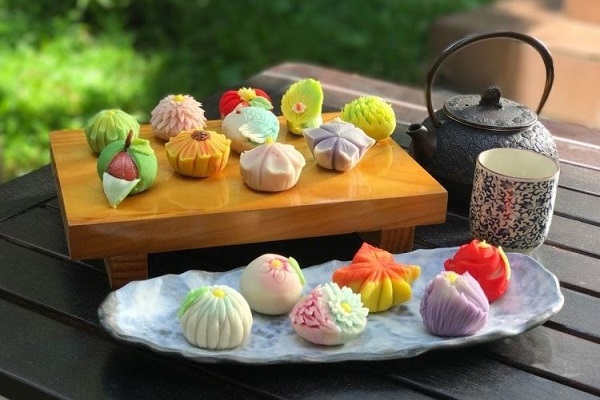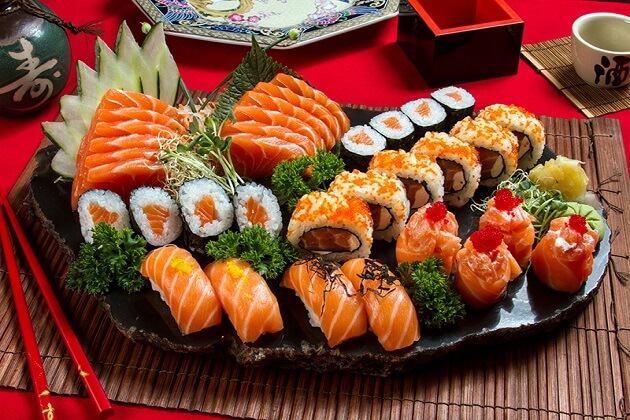Japanese cuisine is the most famous in the world because of the sophistication in the processing and decoration of each dish, the taste of Japanese food is often elegant, gentle, suitable with the natural atmosphere of each season, bold own identity. Japanese cuisine does not abuse too many spices, but focuses on highlighting the fresh, pure, natural flavors of the dish. The taste of Japanese food is usually ethereal, gentle and suitable for each season. Due to the geographical location surrounded by the sea on all sides, seafood and seaweed make up the majority of the Japanese diet. The main food of the Japanese is rice; The Japanese roll rice in sheets of dark green seaweed, forming a sushi dish, which is considered the national food of Japan. JAPAN NATIONAL FOOD – JAPAN NATIONAL DISH
What to eat in Japan?: https://xinvisaquocte.com/what-to-eat-in-japan-japanese-specialties/
High-strength sakamai rice wine called sake, derived from Shinto rituals, is also popular. In addition, Japanese dishes also show the delicate aesthetic thinking and ingenuity of the cook when presented with just a few pieces in one corner of the dish, so that diners can still see the beauty of the container. dish.
Vietnam e-visa service for foreigners: https://xinvisaquocte.com/vietnam-e-visa-service-for-foreigners/
PROCEDURE FOR VIETNAM VISA EXTENSION: SEE HERE
JAPAN NATIONAL DISH – NATIONAL FOOD OF JAPAN
Japanese cuisine does not abuse too much spices, but focuses on highlighting the fresh, pure and natural flavor of the dish. The taste of Japanese food is usually elegant, gentle and suitable with the nature of each season. Due to the geographic location surrounded by sea, seafood and seaweed make up the majority of the Japanese diet. The Japanese staple food is rice; Japanese people roll rice in dark blue seaweed plates, forming sushi, is considered the national food of Japan. JAPAN NATIONAL FOOD – JAPAN NATIONAL DISH
In addition, soy-based dishes are of particular importance in Japanese cuisine. In terms of drinks, the Japanese are famous for tea mites, the pure green tea powder made by Zen monks; This is the main type of tea for the tea ceremony, this ritual follows the four main principles “harmony, glass, purity”.
The high concentration sakamai rice wine called sake, derived from the Shinto rituals, is also popular. In addition, Japanese dishes also show the delicate aesthetic thinking and ingenuity of the cook when presented with just a few pieces in one corner of the dishes, so that diners can see the beauty of the utensils. dish.
1. NATIONAL FOOD OF JAPAN – Culinary philosophy
Japanese dishes are subject to the rule of “three five”: five spice, five colors, the five dharma. Five flavors include: sweet, sour, spicy, bitter, salty. Five colors are: white, yellow, red, blue, black. The five methods are: raw, simmered, grilled, fried and steamed. Compared to other countries, Japanese cooking has almost no use of spices. Instead, people focus on the pure flavors of the ingredients: fish, seaweed, vegetables, rice and soybeans. JAPA NESE CULINARY CULTURE – NATIONAL FOOD OF JAPAN
2. NATIONAL FOOD OF JAPAN – Cultural significance
Many Japanese dishes represent good wishes to everyone on the occasion of the new year: sake to eliminate evil spirits and prolong longevity, tofu to wish good health, grilled cod roe to wish the family happy , sea bream sushi wishes prosperity, tempura dish wishes longevity. Shrimp symbolizes longevity, the back of the shrimp is curved, the longer it is. JAPAN NATIONAL DISH
3. JAPAN NATIONAL FOOD – Nutrition
The Japanese diet is called ichi ju san sai: “one soup, three dishes”, eaten with rice (by the Muromochi martial artists). Many nutritional ingredients in Japanese food are very healthy. Soybean-indispensable meals and foods made from soybeans such as miso (soy sauce), tofu, natto help prevent blood vessel congestion; Black sesame seeds help stimulate brain activity, umeboshi sour apricots to filter the blood, kombu seaweed helps reduce cholesterol, fresh tea helps fight cell aging. JAPANESE CULINARY CULTURE – NATIONAL FOOD OF JAPAN
4. Be polite on the table JAPAN NATIONAL DISH
- Ask permission before eating: use the idiom: “Itadakimasu”.
- Thank you after eating: use the idiom: “Gochiso sama deshita”.
- When pouring sake, it is necessary to pour it to someone else. Only when the bottle is drained can it be poured for yourself.
5. Nature in Japanese cuisine JAPAN NATIONAL DISH
Raw fish dish fully preserves the freshness of the natural flavor. These are fish slices about 2.5 cm wide, 4 cm long and about 0.5 cm thick served with mustard, ginger, white radish, seaweed rolled up in perilla leaves dipped in Japanese sweet soy sauce and chili sauce.
– In spring, to signal the end of the cold winter, the Japanese eat fish shirouo and welcome the cherry blossom season with sakura mochi and cherry rice.
– In the summer, the Japanese eat many cool dishes such as eel, grilled eggplant, edamame beans, cold noodles such as: somen thin noodles, cold shrimp noodles, tofu dishes such as Japanese fried rice and bitter melon stir-fried tofu of the Okinawa region. May is tuna season, and June is ayu season. JAPANESE CULINARY CULTURE – NATIONAL FOOD OF JAPAN
– In autumn, the Japanese eat baked sweet potatoes, tempura fried dough rolls and nama-gashi cakes ripe persimmons or ginkgo-shaped. September is the month of the moon, so white stews are popular with abalone, cucumber and bamboo shoots. To dispel the cold of winter, the Japanese eat hot pot, oden soup and red bean tea while hot shiruko.
In addition, the Japanese also eat snow-shaped higashi. In winter, the Japanese also love to eat tangerines, representing the sun and used as a New Year’s gift. The Japanese Lunar New Year meal is called osechi, with an indispensable dish of ozoni rice cakes.
6. JAPAN NATIONAL FOOD – Sushi
Spring (signs: blooming cherry blossoms): Japanese often eat 5 seafood sushi dishes: Hama-guri (made from shellfish), sayori (made from sea fish), tori-gai (made from scallops. Japan), miru-gai (made from shrimp, crab, clams, clams, mussels) and kisu (made from Japanese black sea fish).
Summer (sign: green maple leaf): Japanese make 4 seafood sushi dishes: awabi (made from abalone), uzuki (made from sea bass), anago (made from Japanese sea eel) and aji (made from Japanese tuna).
Autumn (sign: red maple leaf): Japanese eat 3 sushi dishes: Kampachi (fish often change as they grow, from hiramasa – when they are young in summer to kampachi – autumn and after) JAPAN NATIONAL FOOD – NATIONAL FOOD OF JAPAN – JAPAN NATIONAL DISH


